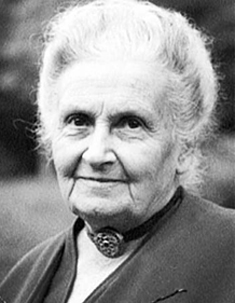a student kneels on a cloth mat while working with wooden montessori learning materials
What is Montessori?
History
Montessori education, established in 1907 by Italian physician Maria Montessori, is a pedagogical approach rooted in the scientific observation of children’s learning processes. Dr. Montessori’s educational methods were based on the understanding that children possess an innate curiosity and drive to learn, and her philosophy emphasized the importance of nurturing and cultivating this natural desire for knowledge.
Central to Montessori education is the concept that children are active participants in their own learning. Rather than simply imparting facts and information to be memorized, the Montessori approach recognizes that children learn best when they are actively engaged and given the freedom to explore and discover at their own pace.

Guiding Principles of Montessori
Child-Centered
- Mixed-age classrooms allow students to have repeated exposure to lessons, as well as become leaders to the younger children in the class.
- Child-centered education is facilitated by a Montessori Guide who is consistently aware of each individual child’s academic progress and emotional development.
Collaborative
- A collaborative approach to education emphasizes long work periods and group project work that reflects the workplace, preparing children to be creative contributors to their communities.
- Integrated lessons with high-quality, hands-on materials that help the child to understand the interconnected nature of all subject areas.
Impactful
- Research studies show that Montessori children rank above average on criteria such as listening attentively, showing responsibility, asking incisive questions, and adapting to new situations.
- Montessori classrooms provide a prepared environment that promotes independence, self-direction, and personal accountability.
Montessori and Public Education
Montessori schools teach the same basic skills as traditional schools and offer a rigorous academic program. As a Texas public charter school, Goodwater Montessori will teach the State learning standards, the Texas Essential Knowledge and Skills, or TEKS, but do so using the Montessori Method and materials.
Montessori classrooms encourage deep learning of the concepts behind academic skills rather than sole memorization of facts contained within the curriculum. Most of the subject areas are familiar — such as math, science, history, geography, and language — but they are presented through an integrated approach that brings separate strands of the curriculum together.
An advantage of the Montessori approach — including multi-age classrooms with students of varying abilities and interests — is that it allows each child to work at their own pace. Students whose strengths and interests propel them to higher levels of learning can find intellectual challenges without being separated from their peers.
The same is true for students who may need extra guidance and support: each can progress through the curriculum at his own comfortable pace, without feeling pressure to “catch up.” We might note that from a Montessori perspective, every child is considered gifted, each in their own way. With unique strengths, skills, and talents, the Montessori child develops as their best self.
The distinctive arrangement of a Montessori classroom mirrors the Montessori method’s differences from traditional education. Rather than putting the teacher, or “guide,” at the focal point of the class, the classroom employs a child-centered approach. Children work at tables or on floor mats — individually or in small groups — and the guide circulates about the room, observing, giving lessons, and assisting students as needed.
Montessori Work Example
While studying a map of Africa, for example, students may explore the art, history, and inventions of several African nations. This may lead them to examine ancient Egypt, including hieroglyphs and their place in the history of writing. The study of the pyramids, of course, is a natural bridge to geometry. The Montessori approach to curriculum shows the interrelatedness of all things and gives students important contextual knowledge that will serve them well for years to come. It also allows students to become thoroughly immersed in a topic—and to give their curiosity full rein.

